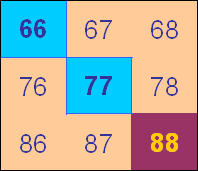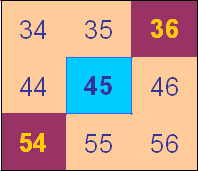Or search by topic
Number and algebra
Geometry and measure
Probability and statistics
Working mathematically
Advanced mathematics
For younger learners
Multiples Grid



- Problem
- Getting Started
- Student Solutions
- Teachers' Resources
Lulu and Sophie from St. Nicolas C. of E. Junior School, Newbury have sent us a solution to the Multiples Grid problem. Thank you both! For the first large square, they say:
The blue numbers are all multiples of 7.
In this square:

they say:
Are you sure the blue could be multiples of 5? In this square:

they say:
In the next square:

they explain:
Finally, in this last square:

Sophie and Lulu wrote:
Thank you for sending us your solution, girls. Well done!
You may also like
Chocolate
There are three tables in a room with blocks of chocolate on each. Where would be the best place for each child in the class to sit if they came in one at a time?
Four Triangles Puzzle
Cut four triangles from a square as shown in the picture. How many different shapes can you make by fitting the four triangles back together?
Cut it Out
Can you dissect an equilateral triangle into 6 smaller ones? What number of smaller equilateral triangles is it NOT possible to dissect a larger equilateral triangle into?

